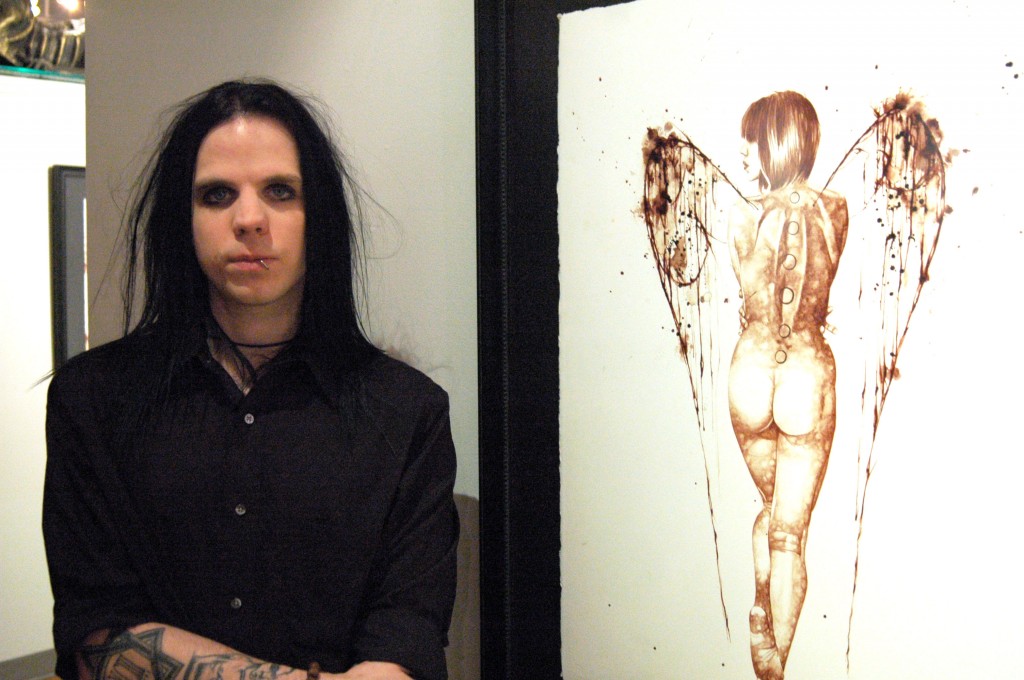
When we refer to an artist’s blood, sweat and tears, we usually mean it figuratively. But not for Nick Kushner. The Los Angeles-based painter has gained quite a reputation for using “the most personal pigment” in his art: his own blood.
Kushner’s solo exhibition, “Aceldama,” opened for a public viewing on Friday, Feb. 7 from 6 to 9 p.m. at the JungleScience Gallery and Art Laboratories on Court Street and will be on display until April. The exhibit featured original works by Kushner, all created with his blood. His paintings, both beautiful and chilling, adorned the walls to be appreciated by students, local artists and community members.
Kushner’s paintings, which feature a unique blend of dark and surrealistic imagery, have been published and exhibited around the world. His rise in the artistic community has been marked by a show in downtown LA with celebrity guests including Marilyn Manson, an interview on A&E and mentions on Playboy Radio.
Kushner first began using blood in his work when he was 15, as a “statement of intent” to assert his identity. Over time, his work evolved, and blood became his full-scale art medium. However, working with blood isn’t easy.
“Blood is a somewhat volatile and fragile medium; its application must be done gradually and delicately in order to portray subtleties,” Kushner said. “A base coat must be laid down and allowed to set before applying additional layers in order to build and develop the different tones and extremes in shades. The style of painting I use can be compared most closely to watercolor.”
Getting blood, though, isn’t as easy as buying paint. Kushner uses professional tools to pull the blood from his body.
“At first, I began by creating a wound and milking the blood directly from the source,” Kushner said. “As my use of blood evolved, I’ve used phlebotomy tools such as butterfly needles and blood storage vials.”
Each painting requires two to six vials of blood. Although the blood storage vials are efficient for long-term works, Kushner still uses a portion of blood fresh from the wound in each of his paintings to maintain his direct artistic connection.
“The philosophy I’ve most closely associated with is alchemy, where the creation process of each piece is a transformative process,” Kushner said. “Because I transmute a literal piece of myself into my work, each painting becomes a living part of myself and each its own independent entity.”
Under titles such as “Angel Lust” and “The Devil Has Four Legs,” each piece is uniquely absorbing and intricately detailed, with clear attention to texture and color value. Kushner’s stunning self-portrait “The Immoralist,” named for an André Gide book of the same title, creates a nearly three-dimensional-looking effect from the expertly layered blood.
“I was impressed to see the range of tones he was able to get out of the blood,” said Derek Smith, a senior majoring in Arabic. “I feel like it’s a pretty original concept.”
Kushner was amicable and approachable, taking time to speak with anyone and everyone that wanted to learn more about him and his art.
Having the exhibit in Binghamton made it all the more personal for Kushner, as much of his artistic and family legacy is located here. “Aceldama” was dedicated to Kushner’s grandfather, Walter Luckert, a Binghamton native and artist who showcased his work throughout upstate New York, including a solo show at Binghamton University in 1979.
“Binghamton has always been important to me,” Kushner said. “It has rich cultural influences beneath the surface, from punk rock to Rod Serling. And although it has this innate element to it, growing up in Binghamton rather than a large city lends itself to a certain isolation. And this I think is important because it allows an individual to have enough space to hone his or her identity, without being inundated by what may be in vogue or going around them in a larger area.”
Kushner’s mother, father, half-sister and fiancee were all in attendance at the exhibition. Ashley Chello, Kushner’s sister, reflected upon her initial reaction after learning of her brother’s chosen medium.
“It was kind of different. I wouldn’t say surprising but definitely different,” Chello said. “The way he took it, the way it has morphed into this fantastic art form is awesome … I’m really proud of him.”
Though the process of extracting blood is painful, Kushner finds it both cathartic and creatively significant.
“Art has always been something which I felt should be meaningful and powerful, more than just a hobby,” Kushner said. “Dependent upon intent and pursuit of the artist, it can be used to portray a concept aesthetically pleasing on simply a surface level or it can have the power to change thought and affect the world.”


